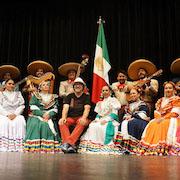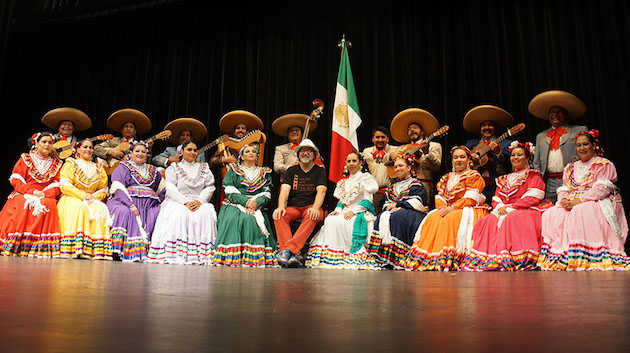
The Golden Gate Symphony initiates its 21st season next Sunday, Nov. 5, with a piñata-busting program of musical goodies, vocal, choral, and instrumental, mostly imported from south of the border. But unlike the San Francisco Symphony’s annual Día de los Muertos (Day of the Dead) concert at Davies Hall, which it follows by a day, G.G. Symphony Music Director Urs Leonhardt Steiner is making, in his own words, “something of a political statement” with his program at the Herbst Theatre, titled ¡Viva Mexico! and subtitled Beyond Border Walls.
“It’s an anti-Trump-wall thing,” Steiner states clearly, “though I also want to celebrate the richness of our cultures and to open doors from both sides, connecting those living in Mexico with members of the Latin community right here in our city, plus my whities, and all the rest of us.”
A few months after Trump’s election, Steiner contacted Mexico City-born Martha Rodriguez-Salazar, whom he’d known when they both served at the Community Music Center, and who had, coincidentally, also advised the S.F. Symphony since the inception of the Día de los Muertos programs a decade ago. “Urs told me that he had a choir from Chapala coming up, and that he wanted to talk with me about it,” Rodriguez recalls. “He told me that the political chaos, including the wall, were making him think very hard about how to build bridges. He sounded inspired. He asked about young singers, and I thought about a couple of Latino voice students of mine who are pretty good. Then he asked for recommendations of composers from Mexico. He said he wanted to promote young Mexican artists who otherwise might not be able to perform, or to be performed.”
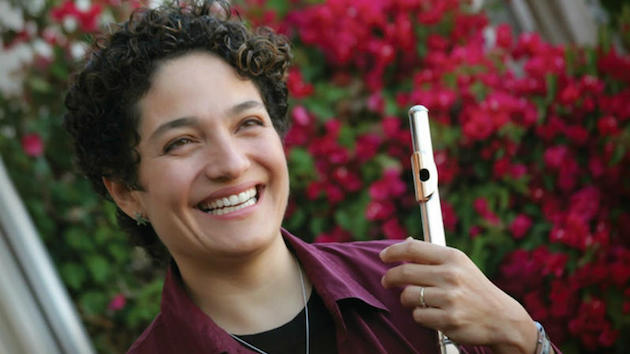
Rodriguez was quite ready to recommend two teenaged mezzos, Mexican-American Alicia Naylor Guerrero, from the Ruth Asawa School of the Arts, and Zahra Rothschild, from Lowell High with Colombian parentage, as well as tenor Joel Ponce, one of her older students. “And I’d been working with [composer] Eduardo Gamboa, my Bernal Hill Players had commissioned a piece from him,” Rodriguez continues. “And I have a nephew, Antonio Flores, who is part of the Núcleo Integral de Composición in Mexico City, which connects with different chamber groups there. Urs said, ‘Let’s bring him up.’ I said, ‘He doesn’t have a visa.’ ‘Well, let’s get him one,’ Urs said. When my nephew heard, he said, ‘A real orchestra wants to play my piece? Sure! And I won’t have to pay for them to play it? Oh my God!’ So his work, Coyohuacan, will be premiered here."
Steiner’s worldview, manifest also a year ago in his presentation of the Chinese oratorio Ask the Sky & the Earth, had its genesis in his native Switzerland, where “we grew up with Italian, French, German, and Romansh [a more direct descendant of Latin], around us all the time,” the conductor points out. Despite some stereotypes about immigrants from Italy, and latter from Turkey and the former Yugoslavia, Steiner is adamant that the Swiss “had and still have a very sensible immigration policy, compared to the United States.”
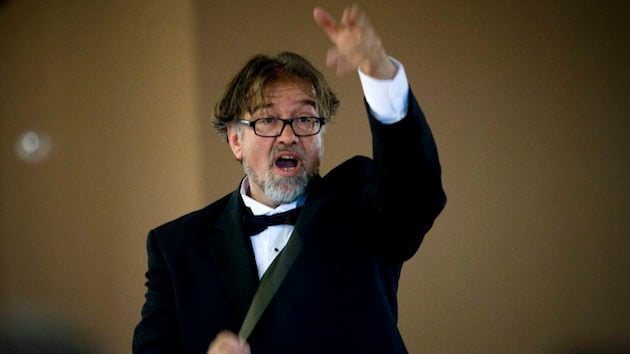
His Swiss family had been used to going to Italy for relaxation and recreation, so when Steiner and his girlfriend at the time decided to immigrate to the U.S. in 1979, “I needed an Italy, so I went to Mexico for three months, and had a wonderful time. And my girlfriend’s first job here was in a burrito place, so I had contact with Latinos here, and while I learned English, I learned Spanish at the same time.”
After setting up roots in San Francisco, where he obtained a master of music at the Conservatory in 1986, Steiner was introduced to the canon of Mexican Baroque and classical composition by Juan Pedro Gaffney Rivera, director of the Coro Hispano. He made regular visits to Mexico City, where “there are three conservatories and six professional orchestras, as well as opera.”
Equally interested in Mexico’s folk music, Steiner met up with a Norteño combo, Los Tigres del Norte, and was invited to sing with them on stage. In 1996, Steiner, by now fluent in Spanish, established a music festival in Oaxaca, with artists from both Mexico City and California. Through a Bay Area plumber and impresario, Miguel Gucho, Steiner was introduced to the Coro Redes y Cantos from Chapala, in the state of Jalisco, not far south of Guadalajara.
“I helped get them some instruments, and then got to visit them down there,” he relates. “It’s incredible: I got there, and half an hour later I was doing music with them! And afterwards, we went to a house, with food and drinks, and they do this thing called bohemia, where they pass around guitars, and everybody sings.” On his next trip to Chapala, Steiner brought along a member of the G.G. Symphony board, who was similarly entranced, and shared the determination to bring the Coro north for the season opener. “The Coro is paid by the state,” Steiner notes. “Mexico spends a lot of money on their culture, compared to the United States.”
The Coro will close out this weekend’s program with “pre-20th-century folk songs,” says Steiner. “Their director, Moisés Real Gómez, is arranging their music for my orchestra, but they’ll also bring five guitars, a Veracruzano harp, and a bass.” The ensemble is arrayed in period costumes, with the men wielding the instruments and the women displaying some dance moves.
Below: A section of the Coro Redes y Cantos performs at the home of G.G. Symphony benefactors Marc Michaelson and Rachele Ferraro. Maestro Steiner is seated at right, in hat. | Credit: Jeff Kaliss
Steiner lays out the first half of the program, starting with the orchestra’s delivery of Gamboa’s Fanfare “in a sort of classical/Mexican genre, with jagged syncopation across the bar lines,” and José Pablo Moncayo’s Huapango, “sort of the second national song of Mexico.” Ponce will solo on “Estrellita,” by the romantic composer Manuel Ponce (no relation), and Guerrero will sing “Mexico lindo y querido." with the singers conducted by Rodriguez, their teacher. The Flores piece, "using indigenous Indio harmonies", will premiere in between the songs, and the evergreen American homage, Copland’s El Salon Mexico, will precede intermission.
Three songs by Nicaraguan Carlos González Siles will open the second half, two of them combining the Coro and the Golden Gate Symphony Chorus. “González is 85 years old, and had a certain amount of success with popular music in the late ’60s and early ’70s,” says Steiner. “Then he fled the country during the Contra thing, and came up here, where he’s been a forgotten man, so I wanted to include him.” The songs will feature solos by Rothschild and Gaspard Mbole, a baritone from Cameroun, who’s also Steiner’s choral assistant. The Coro, as noted above, will cap the evening by showcasing its own repertoire.
Steiner supposes that the G.G. Symphony may be better acquainted with Mexican musical activity than are most ensembles. “Beyond the ‘Freeway Philharmonic,' about half my musicians have worked in Mexico,” he says. “It’s a connection for ‘B’ players who can’t get a big gig up here, but can get a gig in a good orchestra down there, usually a contract of one or two years. They get to play first horn, have a nice little salary by local standards, and they have a great time.”
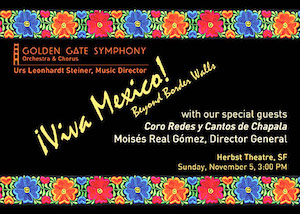
On this side of the border, gaining ethnic diversity in concert audiences has been a challenge. “Thankfully, the G.G. Symphony is working with a public relations person, Victoria Sánchez de Alba, who’s very connected with the Latino world,” says Rodriguez. “I’ve worked with her for the San Francisco Symphony as well, and I’ve seen more and more people from those communities come to the [Día de los Muertos] concerts, people with babies who’d never gone to Davies Hall in their lives.” She also coordinates a young musicians’ program at the Community Music Center, teaching Latin music to kids, and has found that youngsters are often more interested in their ethnic roots than are their parents, despite disregard and harassment from agents of the Trump administration. “They had kids very afraid that their parents were going to be deported,” Rodriguez recounts, “but our parents are supportive, because they’re proud that someone is finally saying that it’s okay to be Mexican.”
“I’ve been doing interviews for [Spanish-language] radio stations and TV,” adds Steiner. “Because I’m going beyond border walls, they are very emotional about this.” His lead-up to the concert has involved contacting congressional representatives to facilitate the granting of travel visas, and he notes that there’s been so far no backlash about the political implications of his project. “I really wouldn’t mind if that would happen,” he chuckles, “because I would sell more tickets.”
Rodriguez admires the serious mission behind the maestro’s enthusiasm and bonhomie. “Thank God for these people who embrace us,” she says. “Urs not only shows a big commitment to our culture, but he has a very generous heart.” Beyond the Mexican sounds enlivening the Civic Center in early November, “it would be great to hear this music throughout the year, and not just once a year.”

